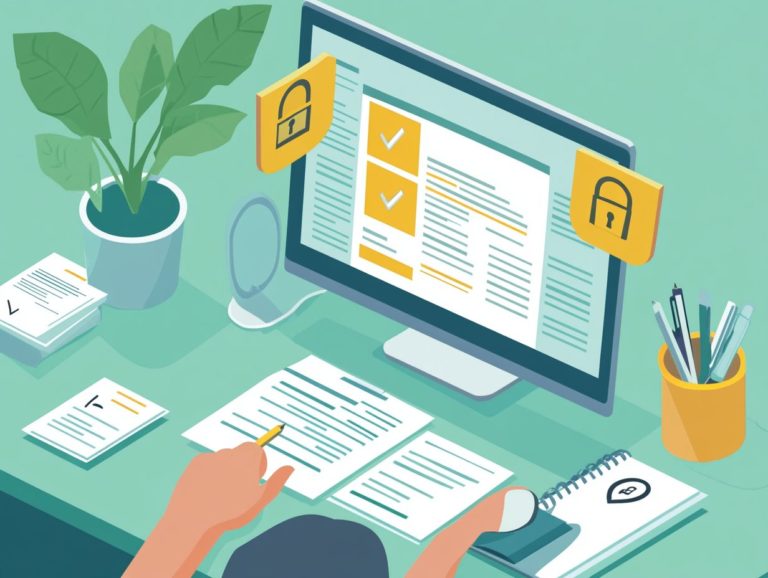the necessity of continuous compliance monitoring
In today s rapidly evolving regulatory landscape, continuous compliance monitoring is not just a luxury; it s a necessity for organizations of all sizes.
This practice ensures that you adhere to laws and regulations while playing a crucial role in risk management and operational efficiency.
This article delves into the importance of compliance monitoring, the various types available, and the many benefits of adopting a proactive stance.
You ll discover practical steps for implementing an effective compliance program, address common challenges, and explore future trends influenced by technological advancements.
Navigate this critical aspect of business management and uncover how it can protect your organization s integrity and pave the way for its success.
Contents
Key Takeaways:

Continuous compliance monitoring is crucial for maintaining ethical and legal standards.
Real-time monitoring allows for prompt identification and resolution of compliance issues, reducing costs and risks.
Implementing a compliance monitoring program requires careful planning and consideration, but can have long-term benefits for organizations.
The Importance of Compliance Monitoring
Compliance monitoring stands as a cornerstone of contemporary business operations. It ensures that you adhere to regulatory requirements and industry standards while fostering trust among stakeholders.
In today s ever-shifting regulatory landscape, the significance of continuous compliance cannot be overstated. By establishing robust compliance frameworks and utilizing compliance management software, you can effectively identify gaps and manage risks.
This safeguards your operational processes and enhances your reputation in the marketplace. Automated checks and real-time alerts fortify your compliance practices, allowing for a proactive approach to fulfilling your compliance obligations.
Understanding Compliance and its Impact
Understanding compliance means recognizing the intricate regulatory standards that govern your business operations. This includes GDPR (General Data Protection Regulation), HIPAA (Health Insurance Portability and Accountability Act), and PCI (Payment Card Industry) standards. These frameworks protect sensitive information and enforce vital privacy measures.
Adherence to these standards is not just important; it s essential in today’s data-driven landscape. Neglecting compliance can lead to significant fines and damage to your reputation.
Adeptly navigating these requirements can build trust among your clients and partners. The landscape is ever-changing, presenting a dual challenge: adapting to new regulations and maintaining robust cybersecurity measures.
You have the opportunity to transform compliance from a mere obligation into a competitive advantage. Leverage strong data protection as a cornerstone of your operational strategy to stand out in the market.
Types of Compliance Monitoring

Compliance monitoring comes in two primary forms: internal and external.
Both play crucial roles in ensuring adherence to compliance standards and frameworks, each contributing uniquely to the overall integrity of your operations.
Internal vs External Monitoring
Internal monitoring assesses your organization’s adherence to compliance practices within its operational processes.
External monitoring evaluates how you stand against industry standards and regulations.
By employing both internal and external monitoring strategies, you can establish a robust compliance framework. This framework not only identifies existing gaps but also promotes continuous improvement.
Internal monitoring often reveals issues that can be swiftly addressed, providing immediate insights into operational efficiencies.
On the other hand, external monitoring offers a broader perspective on compliance trends and risks. This ensures that your organization aligns with industry best practices.
By effectively leveraging both methods, you enhance your ability to adapt to regulatory changes and improve overall compliance metrics. This cultivates a culture of accountability and trust among your stakeholders.
Benefits of Continuous Compliance Monitoring
Continuous compliance monitoring offers many benefits. It greatly improves your organizational efficiency.
By automating compliance processes, you can simplify workflows, receive real-time alerts to stay on top of any issues, and streamline audit preparation.
This proactive approach saves time and enhances operational effectiveness.
Real-Time Detection and Correction

Real-time detection and correction allow you to swiftly address compliance issues as they arise. This ensures adherence to compliance practices and security measures.
Proactive measures are vital for compliance technology. They help you monitor operations and spot irregularities quickly.
By integrating advanced analytics and automated systems, you can receive timely alerts that prompt rapid responses. This enables you to make adjustments before minor issues escalate into major violations.
As compliance requirements evolve, the significance of these alerts is paramount. They assist you in mitigating risks and strengthening your operational processes.
This forward-thinking approach creates a more secure environment, reducing the likelihood of non-compliance and bolstering stakeholder trust.
Cost-Effectiveness and Risk Reduction
Implementing continuous compliance monitoring can enhance cost-effectiveness while reducing risk management challenges. This approach ensures that you remain consistently aligned with regulatory requirements, minimizing the likelihood of costly penalties and disruptions.
By using compliance automation tools tools that help you automate your compliance processes you can streamline monitoring, enabling real-time assessments of adherence to industry standards.
These technologies allow for quicker identification of compliance issues and cultivate a culture of accountability within your organization.
Integrating advanced analytics within these tools gives you the power to gain valuable insights into your compliance landscape. This enables you to formulate informed strategies that further mitigate potential risks and drive substantial cost savings.
Implementing a Compliance Monitoring Program
Implementing a compliance monitoring program involves following essential steps that facilitate effective oversight of your compliance obligations.
Each step is designed to create a robust framework to navigate the complexities of compliance with confidence.
Key Steps and Considerations

Key steps in developing a successful compliance monitoring program include defining your compliance strategies, establishing compliance metrics, and ensuring thorough documentation.
These foundational steps bring clarity to your organization and instill confidence among stakeholders.
By delineating clear compliance strategies, you can prioritize regulatory obligations and align practices accordingly.
Establishing compliance metrics allows for ongoing assessment, enabling proactive adjustments to meet evolving needs and expectations.
Comprehensive compliance documentation serves as a cornerstone for effective oversight. It provides an auditable trail that builds trust with stakeholders.
Ultimately, these diligent efforts contribute to a robust culture of compliance, fostering transparency, accountability, and enhanced organizational integrity.
Challenges and Solutions for Continuous Compliance Monitoring
Continuous compliance monitoring brings forth challenges, particularly in pinpointing compliance gaps and tackling non-compliance issues.
These hurdles necessitate strategic solutions tailored to navigate the complexities of compliance effectively.
Addressing Common Obstacles
Addressing common obstacles in compliance monitoring requires you to use advanced compliance tools. You also need to enhance your vendor management and incident management strategies.
Challenges such as fragmented processes and inadequate communication among teams can arise. Rapidly evolving regulations also contribute to these hurdles. These issues can impede effective compliance management, making it essential to adopt structured protocols and utilize cutting-edge compliance software.
By implementing comprehensive vendor management systems that guarantee all partners meet required standards, you can significantly mitigate risks.
Developing a robust incident management framework enables swift responses to compliance breaches. This ensures that any issues are documented and resolved efficiently.
Together, these strategies enhance compliance rates and cultivate a culture of accountability and transparency within your organization.
Future of Compliance Monitoring
Get ready! The future of compliance monitoring is about to transform dramatically, fueled by technological advancements that elevate compliance technology and Governance, Risk Management, and Compliance (GRC) platforms.
This evolution promises to redefine how organizations navigate the complexities of regulatory requirements. Smarter solutions that enhance efficiency and accuracy will be integrated into this new landscape.
Technological Advancements and Trends
Technological advancements in compliance automation and analytics are transforming the landscape. They provide you with enhanced insights and stronger adherence to cybersecurity standards and data privacy regulations.
Organizations like yours are increasingly embracing sophisticated software solutions and machine learning algorithms. These innovations streamline monitoring processes and improve the accuracy of compliance reporting. They also lighten the load for your compliance teams and promote a proactive stance on risk management through real-time analysis.
However, integrating these technologies isn’t without challenges. You’ll need to invest in ongoing staff training and navigate potential complications from data integration across various platforms.
As you traverse these complexities, maintaining a balance between harnessing the advantages of automation and ensuring robust data security is essential.
Frequently Asked Questions
What is the necessity of continuous compliance monitoring?
Continuous compliance monitoring is necessary to ensure that an organization consistently meets regulatory and legal requirements to avoid penalties and maintain compliance.
How does continuous compliance monitoring differ from traditional compliance monitoring?
Traditional compliance monitoring involves periodic checks and audits, while continuous compliance monitoring is an ongoing process that constantly tracks and evaluates compliance in real-time.
What are the benefits of implementing continuous compliance monitoring?
Continuous compliance monitoring allows organizations to quickly identify and address any compliance issues, reduce the risk of non-compliance, and improve overall compliance posture.
What types of regulations and standards require continuous compliance monitoring?
Many industries, such as healthcare, finance, and government, are subject to strict regulations and standards that require continuous compliance monitoring, including HIPAA, PCI DSS, and GDPR.
How can an organization ensure effective continuous compliance monitoring?
To ensure effective continuous compliance monitoring, organizations should establish clear compliance policies and procedures, regularly review and update them, and implement automated compliance monitoring tools and systems.
What are the consequences of not having a continuous compliance monitoring program in place?
Not having a continuous compliance monitoring program can result in hefty fines, damage to reputation and brand, and legal consequences. It can also leave an organization vulnerable to security breaches and data leaks.
Don’t wait! Start enhancing your compliance today for a secure future.






